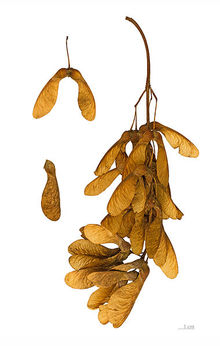A new study published this month in the UK Equine Veterinary Journal reports that toxins from the seeds of the tree Acer pseudoplatanus are the likely cause of Atypical Myopathy (AM) in European horses.

Seeds of the European sycamore thought responsible for AM in horses
Atypical Myopathy is a highly fatal horse muscle disease in the UK and Northern Europe with approximately twenty European countries having reported the disease.
© 2013 by Didier Descouens
The common name for this tree is sycamore in the UK but it is also known as the sycamore maple in some other countries. There is further potential for confusion because a completely different tree, Platanus occidentalis, is known as the sycamore or American Sycamore in the USA.
The new research follows research in the USA published earlier that linked toxins from the box elder tree (Acer negundo) to Seasonal Pasture Myopathy (SPM), the US equivalent of Atypical Myopathy. The discovery marks an important step for the future prevention of this fatal disease.
Atypical Myopathy is a highly fatal muscle disease in the UK and Northern Europe. In ten years, approximately twenty European countries have reported the disease. Incidences tend to occur repeatedly in the autumn and in the spring following large autumnal outbreaks.
Horses that develop AM are usually kept in sparse pastures with an accumulation of dead leaves, dead wood and trees in or around the pasture and are often not fed any supplementary hay or feed. SPM is a very similar disorder, prevalent in Midwestern USA and Eastern Canada that is now known to be caused by the ingestion of hypoglycin A, contained in seeds from the box elder tree.
The new European research was conducted by an international team led by Dominic Votion, University of Liege and involved 17 horses from Belgium, Germany and The Netherlands, suffering from Atypical Myopathy.
High concentrations of a toxic metabolite of hypoglycin A, were identified in the serum of all of the horses. The pastures of 12 of the horses were visited by experienced botanists and the Acer pseudoplatanus, the sycamore maple, was found to be present in every case. This was the only tree common to all visited pastures.
Researchers believe hypoglycin A is the likely cause of both AM in Europe and SPM in North America. The sycamore and the box elder are known to produce seeds containing hypoglycin A and the pastures of the afflicted horses in Europe and the USA were surrounded by these trees.
Researchers at the Universities of Minnesota and Liege are continuing their work to try to uncover exactly how the equine disease occurs.
The researchers indicated that further analysis of the seeds and other tissues from Acer species needs to be performed along with sampling of plant materials over multiple seasons and at various stress levels.
Additionally, they did not rule out more complex explanations for the seasonality of disease occurrence such as: animals may begin feeding on seed materials in response to depletion of more palatable choices under drought conditions; or simple explanations such as high wind events driving seeds into fields.
Although limited examples are available, the experience of animals at a pasture site might also confer some degree of behavioral resistance to poisoning due to exposure at sub-lethal levels with prior exposure to seeds in the pasture.
Professor Celia Marr, Editor of Equine Veterinary Journal said: "This is an important advancement in our understanding of what causes AM and how it can be prevented. In immediate practical terms owners can take prompt measures to avoid exposing their horses to sycamore seeds this autumn."
"Where horses are grazing in the vicinity of sycamore trees, it is imperative that they are provided with sufficient supplementary feed as this will minimize the risk that horses might be tempted to ingest seeds containing this toxin. This must be done carefully and leaving wet hay on the ground should be avoided so providing extra carbohydrate feeds may be more practical."
